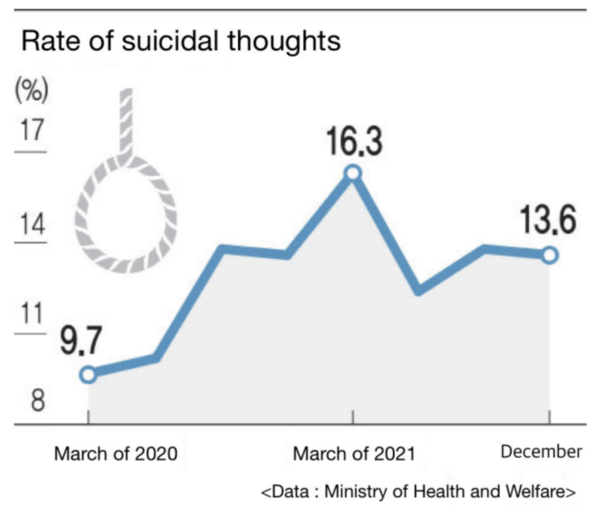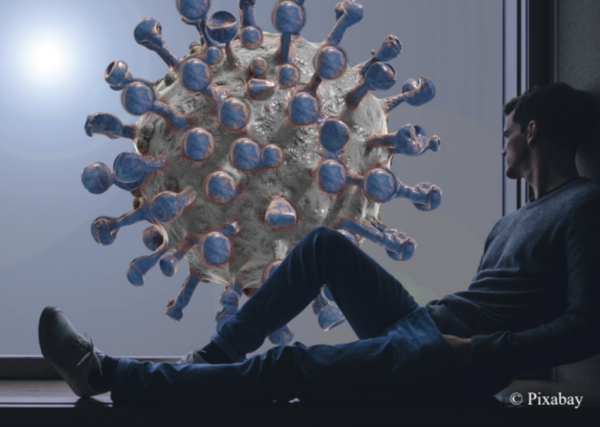One day morning, you are walking through a richly-wooded forest. You can hear birds chirping and see flowers blooming. You take a deep breath, reckon to feel refreshed. But at that moment, something is blocking you. It’s a mask.
It was difficult to imagine our daily life changed due to Corona until the early days of the COVID-19 crisis. Indeed, we didn’t know it would cause us much damage back then, but many parts of our lives have changed over the years. For example, the mask has become a necessity in places such as schools and gyms, going to work in a living room rather than your office became common, and many school classes were quickly switched to untact.
The Corona 19 virus, which was expected to pass quickly, has raged for the past two years. And it has infiltrated our daily lives and is changing our lives completely.
The prolongation of the pandemic allowed the virus to penetrate deeper and even affect and even affect our mental health. The spread of COVID-19 has put us in an unstable situation, and as a result, people’s mental health has also suffered. While focusing on the virus, mental health problems have grown bigger and bigger. Now, we need to build psychological health barriers as well as quarantine against the flurry of viruses.
As social distancing has been prolonged, face-to-face contact, which was regarded as common previously, has rapidly decreased. As a result, the number of people who fall into depression and lethargy has increased. And the term ‘Corona Blue,’ which makes people feel depressed and nervous, was newly coined by the continuing pandemic.
According to the ‘2021 COVID-19 National Mental Health Survey’ by the Ministry of Health and Welfare, the proportion of depression risk groups in the fourth quarter of last year was 18.9%. In other words, one in five Koreans is at risk of depression due to the prolonged COVID-19 crisis.
In addition, the number of patients(64,7691 people) diagnosed with depression(depressive episode recurrent depressive disorder) in the first half of last year showed the most significant increase in the number of patients in the past ten years.
Males in their 30s(22.4%) had the highest rate of suicidal thoughts, followed by females in their 20s(17.3%) and males in their 20s(17.2%). This result shows warning signs were ringing from the mental health of the 2030 generation, who are under higher pressure than before in entrance examination and employment due to COVID-19. Jeong Eun-young, a mental health policy officer at the Ministry of Health and Welfare, emphasized, “As COVID-19 is prolonged, the people’s mental health is deteriorating, such as an increase in suicide rates, so management is necessary.”

In addition, it is said that the probability of a diagnosis of depression increases when infected with COVID-19. The British Journal of Medicine (BMJ) revealed this in a paper tracking the progress of 154,000 COVID-19 confirmed cases; the research excluded people who had a record of receiving various psychiatric treatments within at least two years.
According to this paper, confirmed patients were 39% more likely to be diagnosed with depression and 35% more likely to be diagnosed with an anxiety disorder than the uninfected group. Also, confirmed patients were 38% more likely to develop stress disorder and 41% more likely to develop sleep disorder than uninfected people. The side effects of COVID-19 did not stop here. Cognitive problems were also pointed out. Compared to those who did not have COVID-19, they were 80% more likely to suffer from issues such as forgetfulness, and the likelihood of being addicted to various drugs was said to be at least 20% higher.
Regarding this study, Paul Harrison, a professor of psychiatry at Oxford University, said, “It has been clearly confirmed that mental problems occur after getting Corona,” adding, “Corona infection can also be seen as affecting mental health.” Consequently, the research shows that physical treatment is essential when infected with COVID-19, but mental therapy is also necessary.
Following ‘Corona Blue,’ which is a feeling of depression because of Corona, ‘Corona Red,’ which means depression expressed as anger, threatens our mental health. ‘For-retaliation crimes’ have been happening one after another by pouring negative emotions such as dissatisfaction and irritation from an unprecedented disease to a weaker target than themselves. When the convenience store part-timer informed a man that eating and drinking after 9 p.m. is prohibited, the man flung milk at the part-timer’s head, saying, “Then why do you accept customers?” Also, a woman poured hot coffee on a clerk because she was dissatisfied with the cafe’s service, which left the clerk with severe burns.
Baek Jong-Woo, a professor of psychiatry at Kyunghee University, said, “Right after the disaster, the anxiety level is the highest, then as time passes, depression and anger increase.”, “It concerns us that someone that throws outrage in public or releases depression and anger to the socially disadvantaged.”
The sense of isolation and anxiety about health and livelihood due to COVID-19 has accumulated. Then, at some point, you experience a mental state where uncontrollable anger is yelling up. Especially people who usually have self-righteous thoughts, in severe cases, use violence against others.
Looking at the monthly increase in patients with IED(Intermittent explosive disorder) through the Health Insurance Review and Assessment Service's health care big data opening system, the number of patients increased by more than 100 from 519 in June 2019 before COVID-19 to 624 in June 2021. This shows that patients diagnosed with depression and patients with anger control disorder increased significantly through the
COVID-19 period.

In fact, there is also a study showing that the number of angry people angry has increased nationwide since COVID-19. Professor Yoo Myung-Soon’s research team at Seoul National University Graduate School of Health announced a study showing that the number of angry people more than doubled from 11.5% in March 2020 to 25.3% in August 2020.
The problem is that if anger is not properly controlled, it can lead to crimes such as violence and abuse. For instance, someone assaulted a taxi driver who asked him not to put his feet on the cradle between the driver’s seat and the front passenger’s seat. In addition, some people were sentenced to probation for assaulting a police officer who demanded a temperature measurement to prevent infection with COVID-19. As a more severe example, a video was uploaded to an online community in January 2022. A stray cat was dumped into an iron cage, and then, while the cat was struggling to breathe, it got burnt to death - the whole process was videotaped. In other words, someone locked the cat in an iron cage and burned it to death. Afterward, the police launched an investigation into the incident.
The cause of anger is the COVID-19 situation and the government and society that cannot solve it, but people express anger to weaker beings than themselves. As crimes caused by anger control disorders increase, anyone can be the victims of the crimes.
In the COVID-19 situation, people feel depression and anger that they can not resolve with their effort and mental problems are increasing. When depression and anger go inward, depression gets more profound like flameout, defined as ‘Corona Blue’. When they go outward, the flame of anger goes fury, referred to as ‘Corona Red.’ Accordingly, personal and social consciousness about people’s mental health is needed beyond the risk of COVID-19 infection. Experts say that we can overcome these problems with interest and effort from individuals, governments, and society.
Individually, experts advise that first of all, it is necessary to carefully check whether you feel different moods or symptoms than before the outbreak of COVID-19. Now that COVID-19 has passed three years, you should look back on your anger and depression. You can check yourself with the ‘Depression Assessment Tool (PHQ-9; Patient Health Questionnaire-9)’, a self-diagnostic evaluation scale. Experts say regular lifestyle and exercise are also essential to protect mental health. Through this, anger and depression can be relieved and resolved. In particular, it is important to be awake when there is sunlight and sleep when it is dark, and keeping a mealtime is also an important factor in maintaining biorhythms. It is also said that exercise helps activate the brain's function to control depression. If necessary, it is recommended that you receive treatment actively rather than taking depression and anger lightly.
Socially, it is necessary to establish a counseling center to detect and treat symptoms quickly. For instance, in Imsil-gun, Jeollabuk-do, various integrated mental health promotion projects, including psychological support, are being carried out. Counseling services, psychological support kits, suicide prevention education, and stress management help maintain stable daily life and psychological recovery. As such, various projects to resolve blind spots for mental illness should be promoted.
In addition, as the working base of the low- income class worsened due to COVID-19, the polarization of income became more severe, and the economic base of self-employed people and small businesses collapsed. They even made extreme choices due to mental problems caused by closure and bankruptcy. There is a need for support for people who are experiencing mental problems as well as economic hardship due to COVID-19.
As such, personal and social attention and effort are needed for mental problems increasing in the COVID-19 situation. Let’s participate and be concerned as individuals and members of society.


